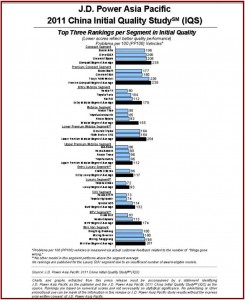The overall initial quality of new vehicles in China has reached an historic high after improving steadily during the past decade, according to the latest study released this morning.
Overall initial quality of vehicles sold in Chain averages 162 PP100 (problems per 100) in 2011. This is the lowest problem rate recorded since the inception of the study in 2000, according to J.D. Power Asia Pacific. Not surprisingly, models from Japanese brands, as a whole, have the lowest problem incidence in the China market in 2011 with an average of 108 PP100.
This year IQS has improved by an average of 6 PP100 from 2010. This is primarily because Korean brands improved by 42 PP100 from 2010. Initial quality of international brands, as a whole, has improved by 4 PP100 from 2010 to an average of 131 PP100 in 2011.
In stark contrast, initial quality among models of Chinese domestic brands has declined in 2011. Problem incidence has increased by 8 PP100 from 2010 to 232 PP100. After narrowing during the past several years, the gap in initial quality between Chinese domestic brands and international brands has widened by 12 PP100 in 2011, compared with 2010 according to Power.
The study, in its 12th year, examines problems experienced by new-vehicle owners within the first two to six months of ownership. Vehicle problems are examined in two categories—quality of design and quality of production (defects and malfunctions). The overall initial quality score is determined by problems reported per 100 vehicles with a lower rate of problem incidence of course indicating higher quality.
“The most commonly reported issues by owners of Chinese domestic brands involve putting manual transmissions in gear,” said Chris Chen, automotive research manager at J.D. Power Asia Pacific, Shanghai. “Other problems that manufacturers need to work on are the engine losing power when the air conditioning is turned on and excessive fuel consumption.”
Models from Japanese manufacturers rank highest in seven of the 11 award segments. Models of Chinese domestic brands rank highest in the mini van and lower premium midsize segments.
Models ranking highest overall in their respective segments include:
- Compact: Suzuki Alto
- Premium compact: Suzuki Swift
- Entry midsize: Honda Fit
- Midsize: Nissan Tiida and Toyota Corolla EX (in a tie)
- Lower premium midsize: Chevrolet Epica and FAW Besturn B70 (in a tie)
- Upper premium midsize: MAZDA6
- Entry luxury: BMW 3 Series
- Luxury: Toyota Crown
- SUV: Honda CR-V
- MPV: Buick GL8
- Mini van: Dongfeng Xiaokang
Excessive fuel consumption has remained the most frequently reported problem since 2007. The study finds that new-vehicle owners in China tend to be particularly sensitive to noise problems, with brake noise, wind noise, engine noise and fan/blower noise accounting for four of the top 10 most commonly reported issues.
According to the J.D. Power Asia Pacific China Sales Satisfaction Index Study, initial quality is by far the most important driver for purchase decisions by new-vehicle buyers. The 2011 China Initial Quality Study finds that among owners who have a problem-free experience with their vehicle, 38 percent indicate they will definitely recommend their brand to others, while 21 percent indicate they will definitely repurchase the brand. In contrast, definite recommendation and repurchase rates decline to 27 percent and 14 percent, respectively, among owners who experience more than one problem with their vehicle.
In another recent Power Survey, Fuel economy is among the top rejection reasons for Chinese car buyers, particularly given the sharp increases in gas prices that have occurred in recent years. Fuel economy is becoming a challenge for nearly all manufacturers in China, but particularly so for U.S. brands. Approximately one in four Chinese rejecters (24%) say they rejected a model of a U.S. brand because they expected better fuel economy. (See Competition in Chinese Auto Market Results in Cross Shopping Record. U.S. Brands Suffer Because of Poor Fuel Economy)
The 2011 China IQS is based on evaluations from 17,675 owners of new vehicles purchased between October 2010 and June 2011. The study analyzes models in 12 vehicle segments, and includes 155 different passenger-vehicle models covering 56 different makes. The study was fielded from April to August 2011 in 37 major cities across China.


